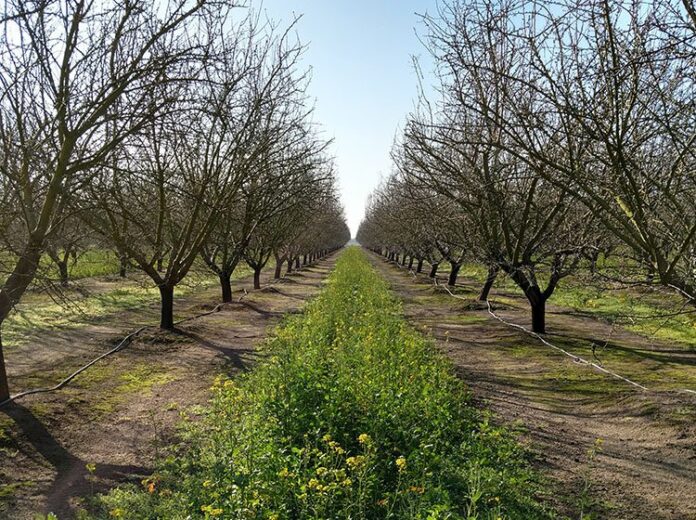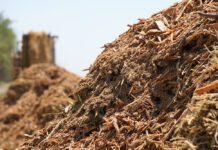
Navel orangeworm (NOW) is a primary pest affecting almond orchards, causing substantial economic losses through nut damage and the spread of aflatoxin. Current management practices rely heavily on winter sanitation, well-timed insecticide sprays, timely harvests and mating disruption to reduce NOW populations. In addition, research efforts are looking into the potential of sterile insect release to combat this widespread pest.
NOW greatly reduces crop profitability and is the number one insect pest in almonds. Estimates show as little as 2% damage can cost almonds $105 million, pistachios $60 million and walnuts $26 million in lost yield in addition to the costs of managing this pest. With depressed nut prices and a changing climate, NOW damage has become exacerbated over the years. Historically, there were three flights of NOW per year, and now four flights have become an industry standard with a fifth flight becoming a likely inevitability. Early management of this pest is vital in reducing crop damage. Each female NOW moth can lay between 80 to 200 eggs, and multiple larvae can develop in each nut. These large offspring numbers give NOW the potential to multiply by 1,900% with each generation. In combination with this generational growth, the largest flight occurs when the crop is most vulnerable: during hull split.
In addition to NOW, a new pest is emerging in almonds with the introduction of Carpophilus beetle (Carpophilus truncatus). This beetle was first noted in the San Juaquin Valley in 2023 and is known to overwinter in mummy nuts. Little is known about which pesticides may affect this beetle, prompting UC researchers and extension officers to strongly promote winter sanitation efforts for both NOW and the Carpophilus beetle.
Destruction of mummy nuts has additional effects on yield quality and disease management. Mummy nuts act as pathogen reservoirs for diseases, such as anthracnose and hull rot. These diseases often cause gumming of the peduncle, making infected nuts harder to remove during harvest. Mummy nuts will eventually fall from the tree and, if not removed before the upcoming harvest, can increase the rejection percentage in the following year’s crop. The numerous detrimental effects of mummy nuts highlight the importance of winter sanitation efforts. Integrating cover crops presents a promising approach to supplement these efforts by enhancing mummy nut decomposition, promoting predation and reducing female NOW moth oviposition.
Cover crops influence mummy nut decomposition dynamics by fostering favorable conditions for microbial activity and nutrient cycling in orchard soils. Studies have shown that the presence of cover crops accelerates the breakdown of mummy nuts compared to bare orchard floors. Earlier planted winter cover crops, which were established by November to December, provided better mummy nut decomposition than later-planted cover crops. Additionally, the height and density of the cover crop affected NOW survival with taller, denser plantings, having an increasingly detrimental effect on overwintering NOW populations.
Cover crops can have an indirect influence on some of the underlying causes of sticktights (unharvested nuts which will become mummy nuts). Some of these causes include nutrient or water stress, which leads to uneven ripening of nuts. This situation puts the farmer in the uncomfortable position of shaking some nuts too early or risking NOW infestation of ripe nuts. Cover crops increase water infiltration, boost soil microbial communities and improve the availability of some plant nutrients. These improved soil conditions can have a compounding effect over time, boosting orchard health.
Habitat Complexity
Establishing cover crops enhances the habitat complexity of almond orchards, providing refuge and food sources for natural predators of NOW larvae. Ground beetles and other beneficial insects are observed to increase in abundance and activity in cover-cropped areas. These predators actively prey upon overwintering NOW larva in exposed mummy nuts, thereby reducing the population of NOW before they can infest the following summer crop. However, due to the extremely low treatment threshold for NOW (less than 2% nut infestation), natural predators are rarely relied upon for NOW control.
Cover crops contribute to NOW management by concealing mummy nuts from female moths during their oviposition period. The vegetation acts as visual and olfactory camouflage, making mummy nuts less detectable to female moths seeking suitable egg-laying sites. This reduced visibility and accessibility disrupt the moth’s reproductive cycle, thereby lowering the likelihood of infestation in mummy nuts on the ground. It was found that cover crops did not affect mummy nuts in the tree canopy, demonstrating the continued need to remove them.
While cover crops offer significant benefits in NOW management, they are not intended to replace traditional orchard sanitation practices entirely. Winter sanitation remains crucial for removing mummy nuts that remain after harvest. To address concerns about cover crop interference during mummy nut removal, growers can adopt a strategic planting approach. Some growers plant cover crops in alternate rows while leaving adjacent rows bare to allow for effective winter sanitation efforts without compromising cover crop establishment. Other growers elect to plant the cover crop immediately before or shortly after completing winter sanitation.
Integrating cover crops into almond orchard management strategies provides multifaceted benefits for NOW suppression. By accelerating mummy nut decomposition, increasing predation and hiding mummy nuts from female moths, cover crops contribute to reducing pest pressure early in the almond growing season. This integrated approach enhances the ecological sustainability of almond production while supporting effective pest control practices. Growers are encouraged to consider these findings when developing comprehensive pest management plans that integrate both cover crops and traditional sanitation practices.
Growers located in California can experiment with cover crops at little cost through the Seeds for Bees® program. Seeds for Bees® awards participants with free or subsidized cover crop seed. First year participants can receive up to $2,500 in free seed while second year participants can receive up to $1,500 in free seed. Returning participants can continue to purchase discounted seed through the program. Growers are seeing the value cover crops offer their farms with 40% of all seed shipped through the program being purchased by past participants in 2023.
To qualify, growers need to meet the following criteria: Be in California, be or represent a commercial grower or beekeeper, and be able to plant four or more acres of cover crop. The application is quick to complete and does not require any additional documentation. The Seeds for Bees® program is open from April 1 to August 31. Those interested in applying can access the application link at projectapism.org/sfb-home.
References
Almond Board of California (2021) Navel Orangeworm best management practices. (490) Navel Orangeworm Best Management Practices – YouTube
Wauters, V., & et al. (2023) Developing cover crop systems for California almonds: Current knowledge and uncertainties. Journal of Soil and Water Conservation. Developing cover crop systems for California almonds: Current knowledge and uncertainties | Journal of Soil and Water Conservation (jswconline.org)
Wilson, H., & et al. (2022) Winter cover crops reduce spring emergence and egg deposition of over wintering Navel Orangeworm (Lepidoptera: Pyralidae) in almonds. Environmental Entomology. Winter Cover Crops Reduce Spring Emergence and Egg Deposition of Overwintering Navel Orangeworm (Lepidoptera: Pyralidae) in Almonds | Environmental Entomology | Oxford Academic (oup.com)
Wilson, H., Burks, C., Reger, J., and Wenger, J. (2020) Biology and management of Navel Orangeworm (Lepidoptera: Pyralidae) in California. Journal of Integrated Pest Management. pmaa025.pdf (silverchair.com)
Wilson, H., Rijal, J., and Haviland, D. (2023) New pest infesting almonds and pistachios in the San Juaquin Valley. UC Division of Agriculture and Natural Resources. New pest infesting almonds and pistachios in the San Joaquin Valley – Food Blog – ANR Blogs (ucanr.edu)















